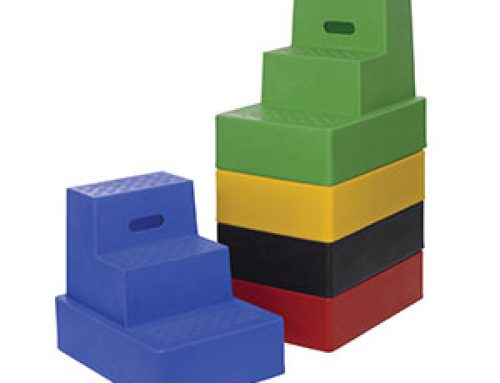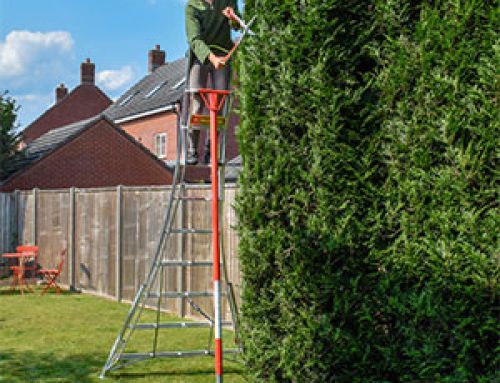Window cleaners routinely use ladders and other scaling equipment to do their job. While most ladders will do the job, there are special A shaped ladders that are designed with window cleaning in mind. These ladders are tapered, becoming narrower towards the top. They also have non-marking rubber tips at the top to prevent causing scratches on a window or plasterwork. Window cleaning ladders are available in metal alloy, wood, or a combination of the two where the side rails are made from wood and the rungs from metal, to give the strength of the metal with the warmer feel of wood on the sides, which is useful in the winter when grasping a cold metal ladder all day would be uncomfortable. The rungs on a window cleaning ladder are often deeper and more grippy than on a normal ladder, as the use of soap and water near the ladder can make them very slippery and cause accidents.
They are made in the A shape for extra stability, as the centre of gravity on a tapered ladder is more central to the ladder itself. They can also be leaned at an angle against a wall, as the tapered top section allows the top of the ladder to rest in between bricks and to the side of window sills in a way that conventional ladders can’t be, and the narrow top means they can be used to access corners and tight spots where a conventional ladder would not fit.
Window cleaning ladders are also available as extension ladders, but the top part of the ladder always tapers in to make the A shape. As with all ladders, there are pieces of additional safety equipment designed to provide extra stability to the legs and deal with uneven ground surfaces. One invention, dreamt up by a window cleaner, is the Ladder Mat Leveller. This piece of kit is a simple set of four rubber pads, which are joined together by a metal loop. The idea is that on sloping or uneven ground the mats can be used to level the area where the feet of the ladder sit. They also help stop slippage and distribute pressure, so on softer ground even using two of the Ladder Mats under each leg can help make the ladder more stable.
To stop ladders slipping on the ground there are ladder stoppers. The Rojak stopper is made from aluminium and rubber; the aluminium is an upside down T shaped piece that is covered in rubber on the bottom. This adds grip between the ladder and the stopper, and between the stopper and the ground, further intensified by the pressure of the ladder and person on the stopper. Another device for the bottom of a ladder is a Footee, which is a pair of metal stoppers with points that stick into grass or the space in between decking, stopping the ladder from slipping when the ground is wet. There are also ladder stand offs, which keep the top of the ladder away from the wall it is leaning on, allowing the top of the ladder to extend past window sills and exterior pipe work. This means extra hand holds for the person up the ladder and better safety.
Since the Health and Safety Executive's 2005 Working At Height Regulations, window cleaners have been encouraged to cut down on the use of ladders and use other methods of accessing and cleaning the windows instead. These other methods include water-fed poles, which pump water up a pipe that has a cleaning pad on the end. The water flows up the pipe and directly on to the window while the window cleaner stays on the ground. These systems can be portable or mounted to a van and are usually made of aluminium or carbon fibre composite depending on the length of the pole. They do require more water than the traditional bucket and squeegee method and even the HSE themselves recognise that the excess water spillage creates a slipping hazard, yet they are still considered safer than ladders.
In Scotland, all new homes are built with reversible windows that turn 180 degrees, allowing the outside of the window to be cleaned from the inside, thereby removing the need for ladders or other equipment entirely.
A ladder is not much use when cleaning the windows of a high rise block of flats or a tall office block. Some such buildings have a window cleaning cradle fitted, which allows the window cleaners to access every window from the outside whilst being on a stable and spacious platform. These window cleaning cradles are beloved of Hollywood films, where they are often seen as an escape route, or a plot device where a window cleaner witnesses a crime or a secret. These systems are operated either electrically or by hand in order to move the unit up and down and across the exterior of the building. Recently a maintenance worker on the Shard building in London was thought to be in danger as the cradle he was working in was swinging in high winds. Luckily, it turned out that he was not in danger, but it looked perilous to the bystanders gathered in the street below.
When a cradle system is not suitable, or too expensive, there are window cleaners out there who work with ropes, and abseil down a building cleaning the windows as they go. These people are highly trained in rope access, climbing and abseiling, and are in high demand as window cleaners and rope access maintenance workers. Often, the cleaners will start on a roof, but may also start from an open floor indoors, which is what happens when glass atria inside a building need to be cleaned. Unusually designed buildings or ones with strange shapes are often cleaned using the rope access method as a cradle would not physically fit on the building. Using rope access also means that tight spaces can be cleaned, which would not be possible using other access methods.
For long jobs requiring rope access, a window cleaner might use a bosun's chair. This is a piece of equipment that was originally used at sea, hence the name. It is a seat attached to a rope that can be hoisted up and lowered by a ground man, providing the person working at height with a more stable and comfortable working position. The ones window cleaners use are designed for use by one person, rather than a team, so they only descend. Although this means the window cleaner has to return to the top of the building on foot each time, this is no different to the rope only situation. All the tools can be tied to the chair so they won't fall to the ground if the window cleaner drops them, and independent safety lines tether the sitter to the seat and building for extra security.
Ground lifts are like a cherry-picker, or firefighter's hydraulic lift. They have a longer platform length to give enough room for several window cleaners, and are used on wide and not too tall buildings that would take longer to clean using the rope access method due to having to return to the top several times.
Self cleaning windows are the ideal solution though; glass is coated with a layer of titanium dioxide, which uses both sunlight and rain to clean the glass. In the sun, dirt on the windows is broken down using the sun's energy. Then when it rains, the water forms a thin layer on the window (rather than forming into droplets like on untreated glass) and this layer washes away the broken down dirt. If you have this type of window there's no need to ever climb up a ladder to wash your windows, let alone get a rope or cradle team in!






Leave A Comment
You must be logged in to post a comment.